Every chapter available in the Samacheer Kalvi Class 11th Bio Botany Solutions subject is explained clearly in an easy way. Learn the depth concept by referring to the Samacheer Kalvi 11th Bio Botany Solutions Chapter 12 Mineral Nutrition Questions and Answers. Have a look at every topic and get the complete knowledge on the Bio Botany Solutions subject. You do not need to search for many materials for a better understanding of Bio Botany Solutions. Just refer to Tamilnadu State Board Solutions pdf and have a grip on the total subject.
Tamilnadu Samacheer Kalvi 11th Bio Botany Solutions Chapter 12 Mineral Nutrition
I believe that the best book is like a best friend to know the complete world by sitting in one place. When you have the best book you have many options to get great knowledge. Selecting the best book will lead to reaching your goal. Students who are looking for the best book to learn Bio Botany Solutions can use Samacheer Kalvi Class 11th Bio Botany Solutions Chapter 12 Mineral Nutrition Questions and Answers. Immediately start your learning with Samacheer Kalvi Class 11th Bio Botany Solutions Solutions Pdf.
Samacheer Kalvi 11th Bio Botany Mineral Nutrition Text Book Back Questions and Answers
Question 1.
Identify correct match.
| 1. Die back disease of citrus | (i) Mo |
| 2. Whip tail disease | (ii) Zn |
| 3. Brown heart of turnip | (iii) Cu |
| 4. Little leaf | (iv) B |
(a) 1. (iii), 2. (ii), 3. (iv), 4. (i).
(b) 1. (iii), 2. (i), 3. (iv), 4. (ii).
(c) 1. (i), 2. (iii), 3. (ii), 4. (iv).
(d) 1. (iii), 2. (iv), 3. (ii), 4. (i).
Answer:
(b) 1. (iii), 2. (i), 3. (iv), 4. (ii).
Question 2.
If a plant is provided with all mineral nutrients but, Mn concentration is increased, what will be the deficiency?
a) Mn prevent the uptake of Fe, Mg but not Ca
b) Mn increase the uptake of Fe, Mg and Ca
c) Only increase the uptake of Ca
d) Prevent the uptake Fe, Mg, and Ca
Answer:
a) Mn prevent the uptake of Fe, Mg but not Ca
![]()
Question 3.
The element which is not remobilized?
(a) Phosphorus
(b) Potassium
(c) Calcium
(d) Nitrogen
Answer:
(c) Calcium
Question 4.
Match the correct combination.
|
Minerals |
Role |
| (a) Molybdenum | 1. Chlorophyll |
| (b) Zinc | 2. Methionine |
| (c) Magnesium | 3. Auxin |
| (d) Sulphur | 4. Nitrogenase |
(a) A – 1, B – 3, C – 4, D – 2
(b) A – 2, B – 1, C – 3, D – 4
(c) A – 4, B – 3, C – 1, D – 2
(d) A – 4, B – 2, C – 1, D – 3
Answer:
(c) A – 4, B – 3, C – 1, D – 2
Question 5.
Identify the correct statement.
i) Sulphur is essential for amino acids Cystine and Methionine
ii) Low level of N,K,S and Mo affect the cell division.
iii) Non – leguminous plant Alnus which contain bacterium Frankia
iv) Denitrification carried out by Nitrosomonas and, Nitrobacter.
a) I, II are correct
b) I, II, III are correct
c) I only correct
d) all are correct
Answer:
b) l, II, III are correct
Question 6.
Nitrogen is present in the atmosphere in huge amounts but higher plants fail to utilize it. Why?
Answer:
The higher plants do not have the association of bacteria or fungi, which are able to fix atmospheric nitrogen.
Question 7.
Why is it that in certain plants deficiency symptoms appear first in younger parts of the plants while in others, they do so in mature organs?
Answer:
In certain plants, the deficiency symptom appears first in the younger part of the plant, due to the immobile nature of certain minerals like calcium, sulphur, iron, boron, and copper.
Question 8.
Plant A in a nutrient medium shows whiptail disease. Plant B in a nutrient medium shows a little leaf disease. Identify mineral deficiency of plant A and B?
Answer:
Plant A in nutrient medium shows whiptail disease: Mineral deficiency is due to Molybdenum.
Plant B in a nutrient medium shows little leaf disease: Mineral deficiency is due to Zinc.
Question 9.
Write the role of nitrogenase enzyme in nitrogen fixation?
Answer:
The role of nitrogenase enzyme in nitrogen fixation:
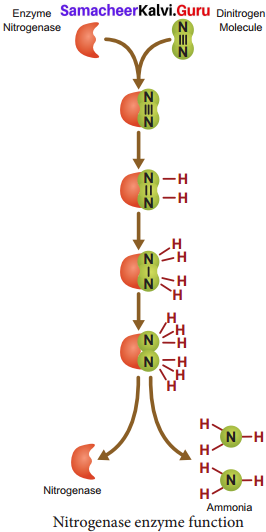
Question 10.
Explain the insectivorous mode of nutrition in angiosperms?
Answer:
Plants which are growing in nitrogen-deficient areas develop an insectivorous habit to resolve nitrogen deficiency.
(i) Nepenthes (Pitcher plant): Pitcher is a modified leaf and contains digestive enzymes. The rim of the pitcher is provided with nectar glands and acts as an attractive lid. When an insect is trapped, proteolytic enzymes will digest the insect.

(ii) Drosera (Sundew): It consists of long club-shaped tentacles which secrete a sticky digestive fluid which looks like a sundew.
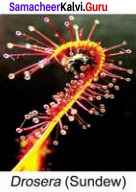
(iii) Utricularia (Bladderwort): Submerged plant in which leaf is modified into a bladder to collect insect in water.
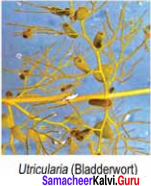
(iv) Dionaea (Venus flytrap): The leaf of this plant modified into a colorful trap. Two folds of lamina consist of sensitive trigger hairs and when insects touch the hairs they will close.
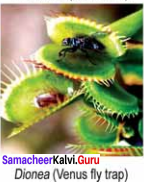
Samacheer Kalvi 11th Bio Botany Mineral Nutrition Additional Questions & Answers
I. Choose the correct answer (1 Mark)
Question 1.
The criteria required for essential minerals was given by
a) Amon and stout
b) Julius von Sachs
c) Liebig
d) Van Helmont
Answer:
a) Arnon and Stout
Question 2.
Which of the following are included under micronutrients:
(a) sodium, carbon and hydrogen
(b) magnesium, nitrogen and silicon
(c) sodium, cobalt and selenium
(d) calcium, sulphur and potassium
Answer:
(c) sodium, cobalt and selenium
Question 3.
Relatively immobile minerals are
a) Nitrogen, Phosphorus, Potassium, Magnesium
b) Calcium. Potassium, Phosphorus, Molybdenum
c) Calcium, Sulphur, Iron, Boron, Copper
d) Carbon, Hydrogen. Oxygen and Sulphur
Answer:
c) Calcium, Sulphur, Iron, Boron, Copper
Question 4.
Selenium is essential for plants:
(a) to prevent water lodging
(b) to enhance growth
(c) to resist drought
(d) to prevent transpiration
Answer:
(a) to prevent water lodging
Question 5.
Law of minium was proposed by
a) Van Helmont
b) Julius von Sachs
c) Liebig
d) Wamburg
Answer:
c) Liebig
Question 6.
Copper shows deficiency symptoms first that appear in young leaves due to:
(a) less active movement of minerals to younger leaves
(b) active movement of minerals
(c) the immobile nature of mineral
(d) none of the above
Answer:
(c) the immobile nature of mineral
Question 7.
The constituent of Chlorophyll is
a) Calcium
b) Manganese
c) Iron
d) Magnesium
Answer:
d) Magnesium
Question 8.
Match the following:
| A. Magnesium | (i) dehydrogenase |
| B. Nickel | (ii) ion exchange |
| C. Zinc | (iii) chlorophyll |
| D. Potassium | (iv) urease |
(a) A – (ii); B – (i); C – (iv); D – (iii)
(b) A – (iii); B – (ii); C – (i); D – (iv)
(c) A – (ii); B – (iv); C – (i); D – (iii)
(d) A – (iii); B – (iv); C – (i); D – (ii)
Answer:
(d) A – (iii); B – (iv); C – (i); D – (ii)
Question 9.
Nitrogen is the essential component of:
(a) carbohydrate
(b) fatty acids
(c) protein
(d) none of these
Answer:
(c) protein
Question 10.
Micronutrient essential for synthesis of Indole Acetic acid and several other enzymes is
a) Copper
b) Iron
c) Zinc
d) Boron
Answer:
c) Zinc
Question 11.
The deficiency of magnesium is the plant, causes:
(a) necrosis
(b) interveinal chlorosis
(c) sand drown of tobacco
(d) all the above
Answer:
(d) all the above
Question 12.
Sulphur is an essential component of amino acids like:
(a) histidine, leucine and aspartic acid
(b) valene, alkaline and glycine
(c) cystine, cysteine and methionine
(d) none of the above
Answer:
(c) cystine, cysteine and methionine
Question 13.
Cuscuta and Rafflesia are respectively known as
a) Total root parasite, Total stem parasite
b) Partial stem parasite, Partial root parasite
c) Total stem parasite, Total root parasite
d) Total saprophyte, Partial saprophyte
Answer:
c) Total stem parasite, Total root parasite
Question 14.
Khaira disease of rice is caused by:
(a) deficiency of boron
(b) deficiency of zinc
(c) deficiency of iron
(d) deficiency of all the three
Answer:
(b) deficiency of zinc
Question 15.
Match the following:
| A. Marginal chlorosis | (i) nitrogen |
| B. Anthocyanin formation | (ii) zinc |
| C. Hooked leaf tip | (iii) potassium |
| D. Little leaf | (iv) calcium |
(a) A – (ii); B – (iii); C – (i); D – (iv)
(b) A – (iii), B – (ii); C – (iv); D – (i)
(c) A – (iii); B – (i); C – (iv); D – (ii)
(d) A – (iv); B – (iii); C – (i); D – (ii)
Answer:
(c) A – (iii); B – (i); C – (iv); D – (ii)
Question 16.
Complete fertilisers include
a) N, P and K
b) Ca, Mg and K
c) N, Ca and Mg
d) None of these
Answer:
a) N, P and K
Question 17.
Which of the statement is not correct?
(a) Aluminium toxicity causes the appearance of brown spots in the leaves.
(b) Aluminium toxicity causes the precipitation of nucleic acid.
(c) Aluminium toxicity inhibits ATPase activity
(d) Aluminium toxicity inhibits cell division.
Answer:
(a) Aluminium toxicity causes the appearance of brown spots in the leaves.
Question 18.
Toxicity of Mn in plant of may cause deficiency …………………………..
a) Fe and Mg
b) S, P and K
c) Ca, CI and Mg
d) N, P and Mn
Answer:
a) Fe and Mg
Question 19.
Nitrogen occurs in the atmosphere in the form of N2, two nitrogen atoms joined together by strong:
(a) di – covalent bond
(b) triple covalent bond
(c) non – valent bond
(d) none of these
Answer:
(b) triple covalent bond
Question 20.
The process of converting atmospheric nitrogen (N2) into ammonia is termed as:
(a) nitrogen cycle
(b) nitrification
(c) nitrogen fixation
(d) ammonification
Answer:
(c) nitrogen fixation
Question 21.
Find out the odd organism:
(a) Rhizobium
(b) Cyanobacteria
(c) Azolla
(d) Pistia
Answer:
(d) Pistia
Question 22.
The first stable product of fixation of atmospheric nitrogen in leguminous plant is
a) No2
b) No3
c) Ammonia
d) Glutamate
Answer:
c) Ammonia
Question 23.
Which are the organisms that help in the nitrogen fixation of lichens:
(a) Anabaena and Nostoc
(b) Anabaena alone
(c) Nostoc alone
(d) Anabaena azollae
Answer:
(a) Anabaena and Nostoc
Question 24.
Leg haemoglobin is a
a) Pigment acting as oxygen scavenger in legumes
b) Hormone fixing in Nitrogen
c) Pigment present in flower petals
d) Oxygen scavenger in BaA
Answer:
a) Pigment acting as oxygen scavenger in legumes
Question 25.
Ammonia (NH3+) is converted into nitrite (NO2–) by a bacterium called:
(a) Nitrobacter bacterium
(b) Rhizobium
(c) Anabaena azollae
(d) Nitrosomonas
Answer:
(d) Nitrosomonas
Question 26.
Plants used as cleaning agents in FTW (ie) Floating treatment wetlands are
a) Eichhomia Pistia, Nelumbium & Typha
b) Limnophila lotus, Potomogeton & Pistia
c) Withania Citronella, Tulsi, Vetivers
d) Bamboo, Hydrilla, Vallisneria & Aloe vera
Answer:
c) Withania Citronella, Tulsi, Vetivers
Question 27.
The bacteria involved in the denitrification process are:
(a) E.coli and Anabaena
(b) Streptococcus and Bacillus Vulgaris
(c) Pseudomonas and Thiobacillus
(d) none of the above
Answer:
(c) Pseudomonas and Thiobacillus
Question 28.
In the process of ammonium assimilation:
(a) Ammonia is converted into nitrites
(b) Ammonia is converted into atmospheric nitrogen
(c) Ammonia is converted into ammonium ions
(d) Ammonia is converted into amino acids
Answer:
(d) Ammonia is converted into amino acids
Question 29.
The one doesn’t fix Nitrogen is ………………………………..
a) Azatobacter
b) Anbaena
c) Spirogyra
d) Nostoc
Answer:
c) Spirogyra
Question 30.
Monotropa (Indian pipe) absorbs nutrients through:
(a) Rhizobium association
(b) mycorrhizal association
(c) microbial association
(d) animal association
Answer:
(b) mycorrhizal association
Question 31.
Cuscuta is a:
(a) partial parasite
(b) total root parasite
(c) obligate stem parasite
(d) partial stem parasite
Answer:
(c) obligate stem parasite
Question 32.
Indicate the correct statement:
(a) Loranthus grows on banana and coconut
(b) Loranthus grows on fig and mango trees
(c) Balanophora is a stem parasite
(d) Viscum is a root parasite
Answer:
(b) Loranthus grows on fig and mango trees
Question 33.
Plants are more adapted to absorb …………… of the following.
a) Nitrate
b) Nitrite
c) Ammonia
d) Nitrogen
Answer:
a) Nitrate
Question 34.
In Utricularia, the bladder is a modified form of:
(a) leaf
(b) stem
(c) tentacle
(d) lamina
Answer:
(a) leaf
Question 35.
Deficiency symptoms of an element tend to appear first in young leaves due to its relative immobility. Which one of the following elemental deficiency would show such symptom
a) Sulphur
b) Magnesium
c) Nitrogen
d) Potassium
Answer:
a) Sulphur
II. Answer the following (2 Marks)
Question 1.
What are the characteristics of Essential minerals?
Answer:
- Necessary for growth and development
- Should have direct role in the metabolism
- Cannot be replaced by other elements
- Deficiency makes the plant impossible to complete the vegetative & reproductive phase
Question 2.
Mention any two actively mobile minerals.
Answer:
Nitrogen and Phosphorus.
Question 3.
What is a chelating agent?
Answer:
A chelating agent is a chemical compound that reacts with metal ions (Iron) from stable water-soluble metal Complexes – (eg. Iron)
Eg. EDTA (Ethylene Diamine Tetra Acetic acid) Siderophores (Biological chelating agent, produced by)bacteria.
Question 4.
What is the role of potassium on osmotic potential of the cell?
Answer:
Potassium (K) plays a key role in maintaining osmotic potential of the cell. The absorption of water, movement of stomata and turgidity are due to osmotic potential.
Question 5.
What is the specialty of Monotropa and Neottia?
Answer:
- These are Angiosperms – They donot have green leaves to prepare food known as saprophytes
- Phey absorb nuitrients from humus rich soil in thick forests through mycorrhizal association,
- They have saprophytic mode of nuitrition.
Question 6.
Explain the role of sulphur in plant biochemistry.
Answer:
Essential component of amino acids like cystine, cysteine and methionine, constituent of coenzyme A, Vitamins like biotin and thiamine, constituent of proteins and ferredoxin plants utilise sulphur as sulphate (SO4–) ions.
Question 7.
Classify Essential elements based on diverse functions.
Answer:
- Structural components: Eg. C, H, O & N
- Activators or Inhibitors of Enzyme Function. Eg. Mg++, P, Zn Ni
- Regulators of osmotic potential of cell Eg. K+, Na+ and CT
- Energy Components Eg. Mg++ and P.
Question 8.
List out any two iron deficiency symptoms in plants.
Answer:
Interveinal chlorosis, formation of short and slender stalk and inhibition of chlorophyll formation.
Question 9.
What is the role of Boron in plant physiology.
Answer:
Translocation of carbohydrates, uptake and utilisation of Ca++, pollen germination, nitrogen metabolism, fat metabolism, cell elongation and differentiation. It is absorbed as borate BO3- ions.
Question 10.
What are the main functions of chlorine? and its deficiency symptoms.
Answer:
- It is involved in Anion – Cation balance, cell division, photolysis of water.
- It is absorbed as Cl ions
- Deficiency disease – Leaf tip wilting.
Question 11.
Explain briefly about aluminium toxicity on plants.
Answer:
Aluminium toxicity causes precipitation of nucleic acid, inhibition of ATPase, inhibition of cell division and binding of plasma membrane with Calmodulin.
Question 12.
State the law of the minimum.
Answer:
Lie big – formulated this law, which states that productivity of soil depends on the number of essential elements present in minimum quantity.
Question 13.
Define nitrogen fixation.
Answer:
The process of converting atmospheric nitrogen (N2) into ammonia is termed as nitrogen fixation. Nitrogen fixation can occur by two methods:
- Biological
- Non – Biological.
Question 14.
Mention any two ways of non – biological nitrogen fixation.
Answer:
Two ways of non – biological nitrogen fixation:
- Nitrogen fixation by chemical process in the industry.
- Natural electrical discharge during lightening fixes atmospheric nitrogen.
Question 15.
Match the following.
| A. Lichens | (i) Anabaena Azolla |
| B. Anthoceros | (ii) Frankia |
| C. Azolla | (iii) Anabaena and Nostoc |
| D. Casuarina | (iv) Nostoc |
Answer:
A – (iii), B – (iv), C – (i), D – (ii).
Question 16.
What is Calmodulin?
Answer:
- Calmodulin is a Ca++ modulating protein in Eukaryotic cells.
- It is a heat-stable protein involved in find metabolic regulation.
Question 17.
Explain the term Transamination.
Answer:
Transfer of amino group (NH3+) from glutamic acid glutamate to keto group of keto acid. Glutamic acid is the main amino acid from which other amino acids are synthesised by transamination.
Question 18.
Explain briefly about total stem parasite.
Answer:
The leafless stem twine around the host and produce haustoria. eg: Cuscuta (Dodder), a rootless plant growing on Zizyphus, Citrus and so on.
Question 19.
What is a bacterioid?
Answer:
A membrane-bound bacterium that is formed inside the root nodule of a leguminous plant is known as a bacteroid.
Question 20.
Explain briefly about the insectivorous mode of nutrition.
Answer:
Plants which are growing in nitrogen-deficient areas develop insectivorous habit to resolve nitrogen deficiency.
III. Answer the following (3 Marks)
Question 1.
What are the criteria required for essential minerals in plants?
Answer:
The criteria required for essential minerals in plants:
- Elements necessary for growth and development.
- They should have direct role in the metabolism of the plant.
- It cannot be replaced by other elements.
- Deficiency makes the plants impossible to complete their vegetative and reproductive phase.
Question 2.
Answer the following questions with reference to nitrogen?
I) The form in which is absorbed from the soil?
II) In which part of the plant it is required’?
III) Two organic compounds in which it is a component
Answer:
I) It is absorbed in the form of N02, NO3-, and NH4 irons.
II) It is required in the me-is1’matic tissues metabolically active cells.
III) It is a constituent of uc1eic acids, Aminoacids, Vitamins Proteins etc. Thus it is a critically very important mineral.
Question 3.
Distinguish between macro and micro nutrients?
Answer:
Macro nutrients:
- Excess than 10 mmole Kg-1 in tissue concentration or 0.1 to 10 mg per gram of dry weight.
- eg: C, H, O, N, P, K, Ca, Mg and S.
Micro nutrients:
- Less than 10 mmole Kg-1 in tissue concentration or equal or less than 0.1 mg per gram of dry weight.
- eg: Fe, Mn, Cu, Mo, Zn, B, Cl and Ni.
Question 4.
Explain Manganese toxicity.
Answer:
- Iron and Manganese exhibit competitive behaviour
- The deficiency ‘Fe’ and ‘Mn’ show similar symptoms.
- If I here is iron toxicity created by excess usage of chelated iron in addition with increased acidity of soil. (pH less than 5.8). It will also affect absorption of Manganese.
- To solve this problem, we should use fertilizer with balance ratio of ‘Fe’ and ‘Mn’
Question 5.
What is meant by Chelating agents? Explain the role of EDTA as chemical chelating agent.
Answer:
Plants which are growing in alkaline soil when supplied with all nutrients including iron will show iron deficiency. To rectify this, we have to make iron into a soluble complex by adding a chelating agent like EDTA (Ethylene Diamine Tetra Acetic acid) to form Fe – EDTA.
Question 6.
Distinguish between leg hemoglobin and Anthocyanin.
Answer:
a) Leg hemoglobin or Legoglobin: is an oxygen carrier found in the nitrogen-fixing root nodules of
leguminous plants.
This by oxygen scavenging lowers oxygen concentration enough to allow nitrogenase to function but also provide Rhizobium (aerobic bacteria) with oxygen for respiration.
b) Anthocyanin:
- It is purple colour pigment found in some plant parts such as flower, fruits etc.
- Anthocyanin formation also occurs in plants due to deficiency of minerals such as Magnesium, Nitrogen, Phosphorus, and Sulphur.
Question 7.
Describe the competitive behaviour of iron and manganese.
Answer:
Iron and Manganese exhibit competitive behaviour. Deficiency of Fe and Mn shows similar symptoms. Iron toxicity will affect absorption of manganese. The possible reason for iron toxicity is excess usage of chelated iron in addition with increased acidity of the soil (pH less than 5.8) Iron and manganese toxicity will be solved by using a fertilizer with a balanced ratio of Fe and Mn.
Question 8.
What is meant by crop rotation or why do farmers raise legume crop (pulses) in between 2 successive paddy crops.
Answer:
- Yes, Repeated Paddy cultivation depletes the soil of nitrogen.
- So prior to paddy, fanners raise, green gram, black gram, soya beans (leguminous plants)
- These plants by their symbiotic association with Nitrogen fixing rhizobium enrich the soil with Nitrogen manure.
- This practice of raising legumes in between paddy crops is known as Crop rotation.
Question 9.
List out the free-living bacteria and fungi responsible for non-symbiotic nitrogen fixation.
Answer:
Free-living bacteria and fungi also fix atmospheric nitrogen.
| Aerobic | Azotobacter, Beijerneckia and Derxia |
| Anaerobic | Clostridium |
| Photosynthetic | Chlorobium and Rhodospirillum |
| Chemosynthetic | Disulfovibrio |
| Free-living fungi | Yeast and Pullularia |
| Cyanobacteria | Nostoc, Anabaena and Oscillatoria. |
Question 10.
Define the term Ammonification.
Answer:
The decomposition of organic nitrogen (proteins and amino acids) from dead plants and animals into ammonia is called ammonification. Organism involved in this process are Bacillus ramosus and Bacillus vulgaris.
Question 11.
Explain briefly Catalytic amination.
Answer:
Glutamate amino acid combines with ammonia to form the amide glutamine.
![]()
Glutamine reacts with a ketoglutaric acid to form two molecules of glutamate.
![]()
(GOGAT – Glutamine – 2 – Oxoglutarate aminotransferase)
Question 12.
Compare the partial stem parasite and partial root parasite.
Answer:
The partial stem parasite and partial root parasite:
- Partial Stem Parasite: eg: Loranthus and Viscum (Mistletoe) Loranthus grows on fig and mango trees and absorbs water and minerals from xylem.
- Partial root parasite: eg: Santalum album (Sandal wood tree) in its juvenile stage produces haustoria which grow on roots of many plants.
Question 13.
Explain the mode of nutrition in pitcher plant.
Answer:
Pitcher is a modified leaf and contains digestive enzymes. Rim of the pitcher is provided with nectar glands and acts as an attractive lid. When insect is trapped proteolytic enzymes will digest the insect.
Question 14.
What is meant by saprophytic mode of nutrition?
Answer:
Saprophytes derive nutrients from dead and decaying matter. Bacteria and fungus are main saprophytic organisms. Some angiosperms also follow saprophytic mode of nutrition. eg: Neottia. Roots of Neottia (Bird’s Nest Orchid) associate with mycorrhizae and absorb nutrients as a saprophyte. Monotropa (Indian Pipe) grow on humus rich soil found in thick forests. It absorbs nutrient through mycorrhizal association.
Question 15.
Describe briefly the method of nitrogen fixation in leguminous plants.
Answer:
Rhizobium bacterium is found in leguminous plants and fix atmospheric nitrogen. This kind of symbiotic association is beneficial for both the bacterium and plant. Root nodules are formed due to bacterial infection. Rhizobium enters into the-host cell and proliferates, it remains separated from the host cytoplasm by a membrane.
IV. Answer the following (5 Marks)
Question 1.
Write an essay on the functions and deficiency symptoms of macro nutrients.
Answer:
Macronutrients, their functions, their mode of absorption, deficiency symptoms and deficiency diseases are discussed here:
(i) Nitrogen (N): It is required by the plants in greatest amount. It is an essential component of proteins, nucleic acids, amino acids, vitamins, hormones, alkaloids, chlorophyll and cytochrome. It is absorbed by the plants as nitrates (NO3).
Deficiency symptoms: Chlorosis, stunted growth, anthocyanin formation.
(ii) Phosphorus (P): Constituent of cell membrane, proteins, nucleic acids, ATP, NADP, phytin and sugar phosphate. It is absorbed as H2PO4+ and HPO4– ions.
Deficiency symptoms: Stunted growth, anthocyanin formation, necrosis, inhibition of cambial activity, affect root growth and fruit ripening.
(iii) Potassium (K): Maintains turgidity and osmotic potential of the cell, opening and closure of stomata, phloem translocation, stimulate activity of enzymes, anion and cation balance by ion – exchange. It is absorbed as K+ ions.
Deficiency symptoms: Marginal chlorosis, necrosis, low cambial activity, loss of apical dominance, lodging in cereals and curled leaf margin.
(iv) Calcium (Ca): It is involved in synthesis of calcium pectate in middle lamella, mitotic spindle formation, mitotic cell division, permeability of cell membrane, lipid metabolism, activation of phospholipase, ATPase, amylase and activator of adenyl kinase. It is absorbed as Ca2+ exchangeable ions.
Deficiency symptoms: Chlorosis, necrosis, stunted growth, premature fall of leaves and flowers, inhibit seed formation, Black heart of Celery, Hooked leaf tip in Sugar beet, Musa and Tomato.
(v) Magnesium (Mg): It is a constituent of chlorophyll, activator of enzymes of carbohydrate metabolism (RUBP Carboxylase and PEP Carboxylase) and involved in the synthesis of DNA and RNA. It is essential for binding of ribosomal sub units. It is absorbed as Mg2+ ions.
Deficiency symptoms: litter veinal chlorosis, necrosis, anthocyanin (purple) formation and Sand drown of tobacco.
(vi) Sulphur (S): Essential component of amino acids like cystine, cysteine and methionine, constituent of coenzyme A, Vitamins like biotin and thiamine, constituent of proteins and ferredoxin. plants utilise sulphur as sulphate (SO4–) ions.
Deficiency symptoms: Chlorosis, anthocyanin formation, stunted growth, rolling of leaf tip and reduced nodulation in legumes.
Question 2.
Describe the role of micronutrients on plant health and function.
Answer:
Micronutrients even though required in trace amounts are essential for the metabolism of plants. They play key roles in many plants. eg: Boron is essential for translocation of sugars, molybdenum is involved in nitrogen metabolism and zinc is needed for biosynthesis of auxin. Here, we will study about the role of micronutrients, their functions, their mode of absorption, deficiency symptoms and deficiency diseases.
(i) Iron (Fe): Iron is required lesser than macronutrient and larger than micronutrients, hence, it can be placed in any one of the groups. Iron is an essential element for the synthesis of chlorophyll and carotenoids. It is the component of cytochrome, ferredoxin, flavoprotein, formation of chlorophyll, porphyrin, activation of catalase, peroxidase enzymes. It is absorbed as ferrous (Fe2+) and ferric (Fe3+) ions. Mostly fruit trees are sensitive to iron.
Deficiency: Interveinal Chlorosis, formation of short and slender stalk and inhibition of chlorophyll formation.
(ii) Manganese (Mn): Activator of Carboxylases, oxidases, dehydrogenases and kinases, involved in splitting of water to liberate oxygen (photolysis). It is absorbed as manganous (Mn2+) ions.
Deficiency: Interveinal chlorosis, grey spot on oats leaves and poor root system.
(iii) Copper (Cu): Constituent of plastocyanin, component of phenolases, tyrosinase, enzymes involved in redox reactions, synthesis of ascorbic acid, maintains carbohydrate and nitrogen balance, part of oxidase and cytochrome oxidase. It is absorbed as cupric (Cu2+) ions,
Deficiency: Die back of citrus, Reclamation disease of cereals and legumes, chlorosis, necrosis and Exanthema in Citrus.
(iv) Zinc (Zn): Essential for the synthesis of Indole acetic acid (Auxin) activator of carboxylases, alcohol dehydrogenase, lactic dehydrogenase, glutamic acid dehydrogenase, carboxy peptidases and tryptophan synthetase. It is absorbed as Zn2+ ions.
Deficiency: Little leaf and mottle leaf due to deficiency of auxin, Inter veinal chlorosis, stunted growth, necrosis and Khaira disease of rice.
(v) Boron (B): Translocation of carbohydrates, uptake and utilisation of Ca++, pollen germination, nitrogen metabolism, fat metabolism, cell elongation and differentiation. It is absorbed as borate BO3- ions.
Deficiency: Death of root and shoot tips, premature fall of flowers and fruits, brown heart of beet root, internal cork of apple and fruit cracks.
(vi) Molybdenum (Mo): Component of nitrogenase, nitrate reductase, involved in nitrogen metabolism, and nitrogen fixation. It is absorbed as molybdate (Mo2+) ions.
Deficiency: Chlorosis, necrosis, delayed flowering, retarded growth and whip tail disease of cauliflower.
(vii) Chlorine (Cl): It is involved in Anion – Cation balance, cell division, photolysis of water. It is absorbed as Cl– ions.
Deficiency: Wilting of leaf tips.
(viii) Nickel (Ni): Cofactor for enzyme urease and hydrogenase.
Deficiency: Necrosis of leaf tips.
Question 3.
Explain the following condition in few sentences.
I) Chlorosis II) Interveinal chlorosis III) Necrosis IV) Anthocyanin formation in leaves
V) Little leaf or mottled leaf.
Answer:
I) Chlorosis:
Chlorosis it leads to the following leaves of plants cause by many mineral deficiency.
Eg: N, K, Mg, S, Fe, Mn, Zn, Mo
II) Interveinal chlorosis:
- It is loss of green coloration in to yellow – in between the areas of veins.
- It may be due to Iron Magnesium or Manganese deficiency.
III) Necrosis :
Death of plants tissues especially leaves by turning into brown or black colour, or tissue due some mineral deficiency or other disease. Eg; Ca, Mg, Cu and K
IV) Anthocyanin formation:
Due to N, P, K, S deficiency the colour of leaves may change from green to purple.
V) Little leaf or mottled leaf – condition:
This symptom occur due to the deficiency of zinc, which in turn is essential for Indole Acetic acid formation.
Question 4.
Give the schematic diagram of nitrogen cycle.
Answer:
The schematic diagram of the nitrogen cycle:
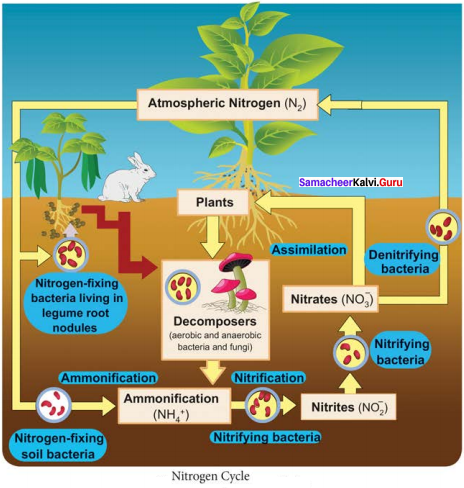
Question 5.
Describe the modes of biological nitrogen fixation.
Answer:
Symbiotic bacterium like Rhizobium fixes atmospheric nitrogen. Cyanobacteria found in Lichens, Anthoceros, Azolla and coralloid roots of Cycas also fix nitrogen. Non – symbiotic (free-living bacteria) like Clostridium also fix nitrogen. Symbiotic nitrogen fixation:
1. Nitrogen fixation with nodulation: Rhizobium bacterium is found in leguminous plants and fix atmospheric nitrogen. This kind of symbiotic association is beneficial for both the bacterium and the plant. Root nodules are formed due to bacterial infection. Rhizobium enters into the host cell and proliferates, it remains separated from the host cytoplasm by a membrane.
2. Stages of Root nodule formation:
- Legume plants secret phenolics which attract Rhizobium.
- Rhizobium reaches the rhizosphere and enters into the root hair, infects the root hair and leads to curling of root hairs.
- The infection thread grows inwards and separates the infected tissue from normal tissue.
- A membrane bound bacterium is formed inside the nodule and is called bacteroid.
- Cytokinin from bacteria and auxin from the host plant promotes cell division and leads to nodule formation
3. Non – Legume: Alnus and Casuarina contain the bacterium Frankia Psychotria contains the bacterium Klebsiella.
Nitrogen fixation without nodulation. The following plants and prokaryotes are involved in nitrogen fixation:
- Lichens – Anabaena and Nostoc
- Anthoceros – Nostoc
- Azolla – Anabaena azollae
- Cycas – Anabaena and Nostoc.
Solution To Activity
Textbook Page No: 95
Question 1.
Collect leaves showing mineral deficiency. Tabulate the symptoms like Marginal Chlorosis, Interveinal Chlorosis, Necrotic leaves, Anthocyanin formation in leaf, Little leaf and Hooked leaf. (Discuss with your teacher about the deficiency of minerals)
Answer:
Symptoms:
- Marginal Chlorosis
- interveinal Chlorosis
- Necrotic leaves
- Anthocyanin formation in leaves
- Little leaf
- Hooked leaf
Minerals:
- Potassium (K)
- Magnesium (Mg)
- Nickel (Ni)
- Phosphorus (P)
- Zinc (Zn)
- Calcium (Ca)
Textbook Page No: 98
Question 1.
Preparation of Solution Culture to find out Mineral Deficiency
1. Take a glass jar or polythene bottle and cover with black paper (to prevent algal growth and roots reacting with light).
2. Add nutrient solution.
3. Fix a plant with the help of split cork.
4. Fix a tube for aeration.
5. Observe the growth by adding specific minerals.
Answer:
The deficiency of minerals like nitrogen, phosphorus, calcium, potassium and sulphur cause stunted growth in plants.
Textbook Page No: 99
Question 1.
Collect roots of legumes with root nodules.
• Take cross section of the root nodule.
• Observe under microscope. Discuss your observations with your teacher.
Answer:
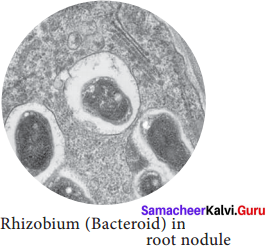
Hope all the information given regarding Class 11th Tamilnadu State Board Bio Botany Solutions will help you to get good knowledge. For any queries, you can contact us and clear your doubts. Connect with us using the comment section. Also, we love your feedback and review. Get your Chapter Wise Samacheer Kalvi Class 11th Textbook Solutions for Bio Botany Solutions Chapter 12 Mineral Nutrition Questions and Answers PDF start learning for the exam.